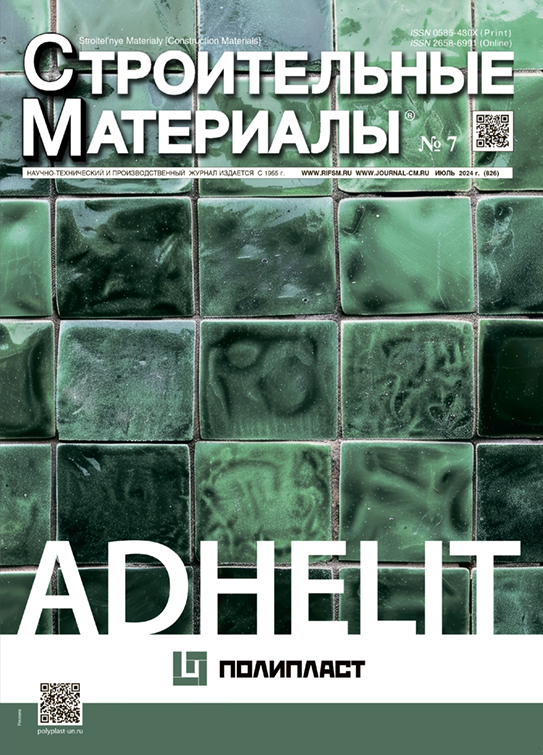Фотокаталитически активный мелкозернистый бетон на основе титаносиликатных отходов
- Авторы: Тюкавкина В.В.1, Цырятьева А.В.1
-
Учреждения:
- Институт химии и технологии редких элементов и минерального сырья им. И.В. Тананаева ФИЦ КНЦ РАН
- Выпуск: № 7 (2024)
- Страницы: 48-53
- Раздел: Современные бетоны
- URL: https://journals.eco-vector.com/0585-430X/article/view/635045
- DOI: https://doi.org/10.31659/0585-430X-2024-826-7-48-53
- ID: 635045
Цитировать
Полный текст
Аннотация
С использованием титаносиликатной добавки, являющейся отходом производства титаносиликатного сорбента, разработан фотокаталитически активный мелкозернистый бетон. Установлено, что введение в состав мелкозернистого бетона титаносиликатной добавки обеспечивает образование дополнительного количества гидросиликатов кальция, преимущественно низкоосновных, повышает плотность цементного камня и снижает дефектность структуры, тем самым способствуя получению более высокопрочных с улучшенными технико-эксплуатационными свойствами бетонов. Для разработанного состава бетона, содержащего 2% (по массе цемента) титаносиликатного порошка, 1,1 мас. % суперпластификатора Glenium 51 при В/Ц 0,42, зафиксировано увеличение прочности при сжатии на 52%, уменьшение водопоглощения на 32%, уменьшение глубины износа и потери массы на 35%, повышение морозостойкости на 3 марки по сравнению с бездобавочным составом. Поверхность мелкозернистого бетона, содержащего отход титаносиликатного сорбента, в реакции разложения метиленового синего проявляет способность к самоочищению под воздействием видимого света, а под ультрафиолетовым светом превышает образцы с коммерческим диоксидом титана. Также проявление самоочищающей способности модифицированного бетона подтверждается уменьшением краевого угла смачивания в процессе облучения ультрафиолетовым светом.
Полный текст
Об авторах
В. В. Тюкавкина
Институт химии и технологии редких элементов и минерального сырья им. И.В. Тананаева ФИЦ КНЦ РАН
Автор, ответственный за переписку.
Email: v.tiukavkina@ksc.ru
канд. техн. наук
Россия, АпатитыА. В. Цырятьева
Институт химии и технологии редких элементов и минерального сырья им. И.В. Тананаева ФИЦ КНЦ РАН
Email: a.tsyriateva@ksc.ru
мл. науч. сотрудник
Россия, АпатитыСписок литературы
- Wang D., Hou P., Stephan D., Huang S., Zhang L., Yang P., Cheng X. SiO2/TiO2 composite powders deposited on cement-based materials: Rhodamine B removal and the bonding mechanism. Construction and Building Materials. 2020. Vol. 241. 118124. https://doi.org/10.1016/j.conbuildmat.2020.118124
- Giada M.C. Gemelli, Manuel Luna, Rafael Zarzuela, M.L. Almoraima Gil Montero, Maria Carbu, Ignacio Moreno-Garrido, María J. Mosquera. 4-Year in-situ assessment of a photocatalytic TiO2/SiO2 antifouling treatment for historic mortar in a coastal city. Building and Environment. 2022. Vol. 225. 109627. https://doi.org/10.1016/j.buildenv.2022.109627
- Sun J., Xu K., Shi C., Ma J., Li W., Shen X. Influence of core/shell TiO2–SiO2 nanoparticles on cement hydration. Construction and Building Materials. 2017. Vol. 156, рр. 114–122. https://doi.org/10.1016/j.conbuildmat.2017.08.124
- Shchelokova E.A., Tyukavkina V.V., Tsyryatyeva A.V., Kasikov A.G. Synthesis and characterization of SiO2–TiO2 nanoparticles and their effect on the strength of self-cleaning cement composites. Construction and Building Materials. 2021. Vol. 283. 122769. https://doi.org/10.1016/j.conbuildmat.2021.122769
- Bjornstrom J., Martinelli A., Matic A. et al. Accelerating effects of colloidal nano-silica for beneficial calcium-silicate-hydrate formation in cement. Chemical Physics Letters. 2004. Vol. 392 (1), pp. 242–248. https://doi.org/10.1016/j.asej.2020.07.016
- Han B., Ding S., Wang J., Ou J. Nano-engineered cementitious composites. Principles and Practices. 2019, p. 731. https://doi.org/10.1016/j.compositesa.2017.01.008
- Li Z., Wang J., Han B., Yu X., Ou J. Investigating size effect of anatase phase nano TiO2 on the property of cement-based composites. Materials Research Express. 2018. Vol. 5. No. 8. https://doi.org/10.1088/2053–1591/aad4e3
- Sun J., Xu K., Shi C., Ma J., Li W., Shen X. Influence of core/shell TiO2–SiO2 nanoparticles on cement hydration. Construction and Building Materials. 2017. Vol. 156, pp. 114–122. https://doi.org/10.1016/j.conbuildmat.2017.08.124
- Khannyra S., Luna M., Almoraima M.L., Addou M., Mosquera M. J. Self-cleaning durability assessment of TiO2/SiO2 photocatalysts coated concrete: Effect of indoor and outdoor conditions on the photocatalytic activity. Building and Environment. 2022. Vol. 211. 108743. https://doi.org/10.1016/j.buildenv.2021.108743
- Zanfir A.-V., Voicu G., Badanoiu A.-I., Gogan D., Oprea O., Vasile E. Synthesis and characterization of titania-silica fume composites and their influence on the strength of self-cleaning mortar. Composites Part B: Engineering. 2018. Vol. 140, pp. 157–163. https://doi.org/10.1016/j.compositesb.2017.12.032
- Wu J., Wang H., Bao L., Zhong J., Chen R., Sun L. Novel raspberry-like hollow SiO2@TiO2 nanocomposites with improved photocatalytic self-cleaning properties: towards antireflective coatings. Thin Solid Films. 2018. Vol. 651, pp. 48–55. https://doi.org/10.1016/j.tsf.2018.02.009
- Тюкавкина В.В., Герасимова Л.Г., Цырятьева А.В. Синтетические титаносиликатные добавки для специальных цементных композитов // Перспективные материалы. 2019. № 4. С. 40–48. https://doi.org/10.30791/1028-978X-2019-4-40-48
- Tyukavkina V.V, Shchelokova E.A., Tsyryatyeva A.V., Kasikov A.G. TiO2–SiO2 nanocomposites from technological wastes for self-cleaning cement composition. Journal of Building Engineering. 2021. Vol. 44. 102648. URL: https://doi.org/10.1016/j.jobe.2021.102648
- Тюкавкина В.В., Щелокова Е.А., Поживина К.А., Касиков А.Г. Нанодобавки на основе диоксида титана и диоксида кремния для самоочищающихся бетонов // Строительные материалы. 2021. № 5. С. 47–53. https://doi.org/10.31659/0585-430X-2021-791-5-47-53
- Gerasimova L.G., Maslova M.V., Nikolaev A.I. Synthesis of the new nano-porous titanosilicates using ammonium oxysulphotitanite. Journal Glass Physics and Chemistry. 2013. Vol. 39 (5), pp. 846–855. https://doi.org/10.1134/S1087659613050076
- Wang D., Hou P., Zhang L., Xie N., Yang P., Cheng X. Photocatalytic activities and chemically-bonded mechanism of SiO2–TiO2 nanocomposites coated cement-based materials. Materials Research Bulletin. 2018. Vol. 102, pp. 262–268. https://doi.org/10.1016/j.materresbull.2018.02.013
- Самбуров Г.О. Технология и применение титаносиликатных сорбентов каркасной структуры для очистки стоков от радионуклидов и катионов токсичных металлов // Теория и практика проектного образования. 2019. № 3 (11). С. 75–80.
- Тюкавкина В.В., Цырятьева А.В. Мелкозернистые фотокаталитические бетоны на основе титаносиликатных отходов // Труды Кольского научного центра РАН. Сер.: Технические науки. 2023. Т. 14. № 4. С. 207–212. https://doi.org/10.37614/2949-1215.2023.14.4.035
- Blossey R. Self-cleaning surfaces-virtual realities. Nature materials. 2003. Vol. 2. No. 5, pp. 301–306. https://doi.org/10.1038/nmat856
Дополнительные файлы













